


There are many popular software development methodologies that different teams follow. Some approaches to app development are best for large, long-term projects, while others are better suited for short-term projects. At Purrweb, we have been in development since 2014, testing different strategies. Some of them we liked, and some we ruled out.
In this article, we’ve collected the top software development methodologies and analyzed each of them in detail. Let’s get started.
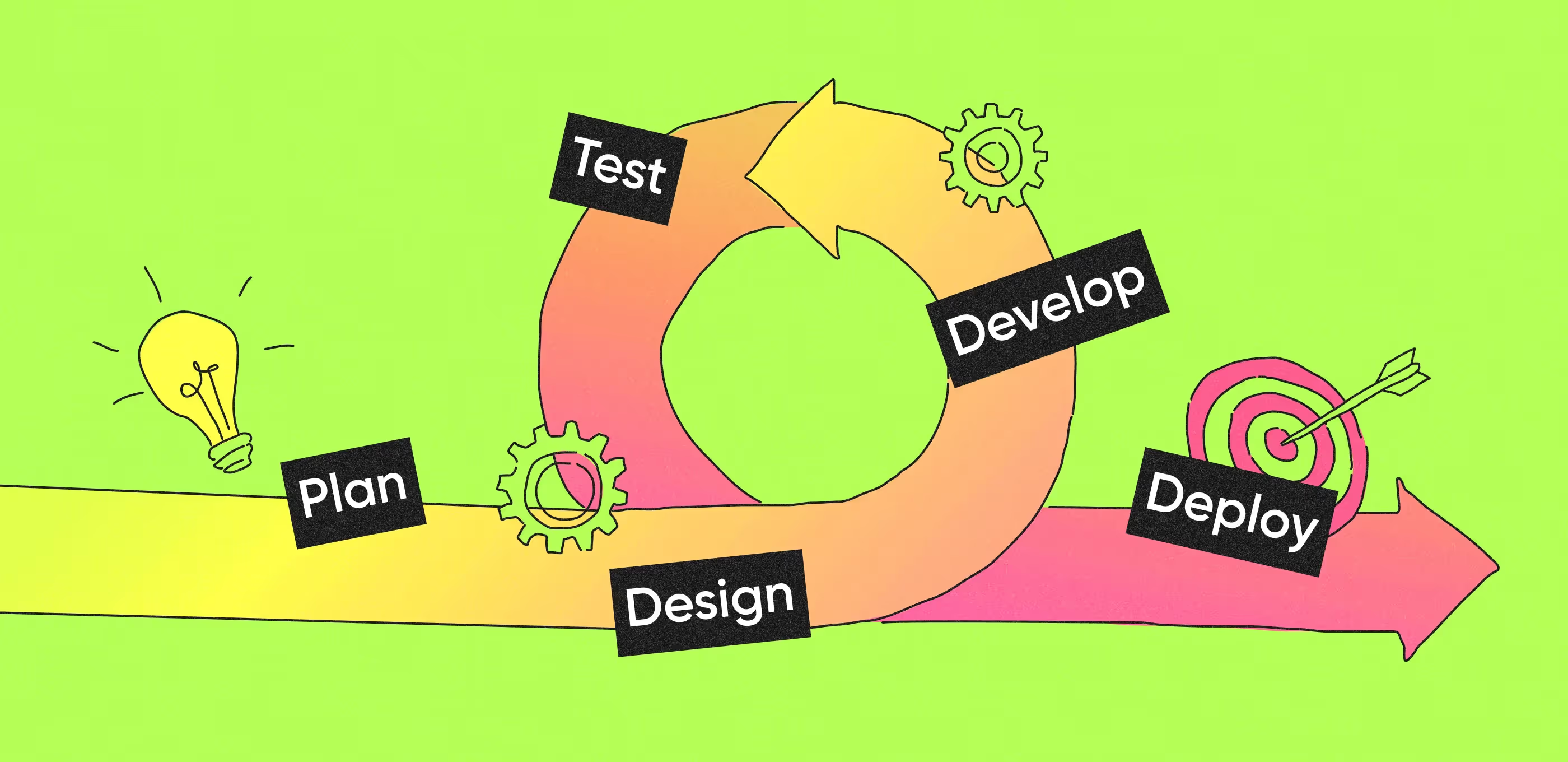
Software development methodologies encompass a defined set of principles, roles, and best practices that govern the process of creating software. These methodologies emphasize careful planning for the software development life cycle, with an important distinction — they do not prescribe specific technical elements.
In essence, these methodologies serve as a structured framework for initiating, executing, and delivering software projects.
They prioritize project management, collaboration, and communication, rather than specifying technical details like programming languages or database choices. Software development teams use them to ensure seamless flow and structural integrity, and to avoid misunderstandings between team members that could potentially result in something like this:
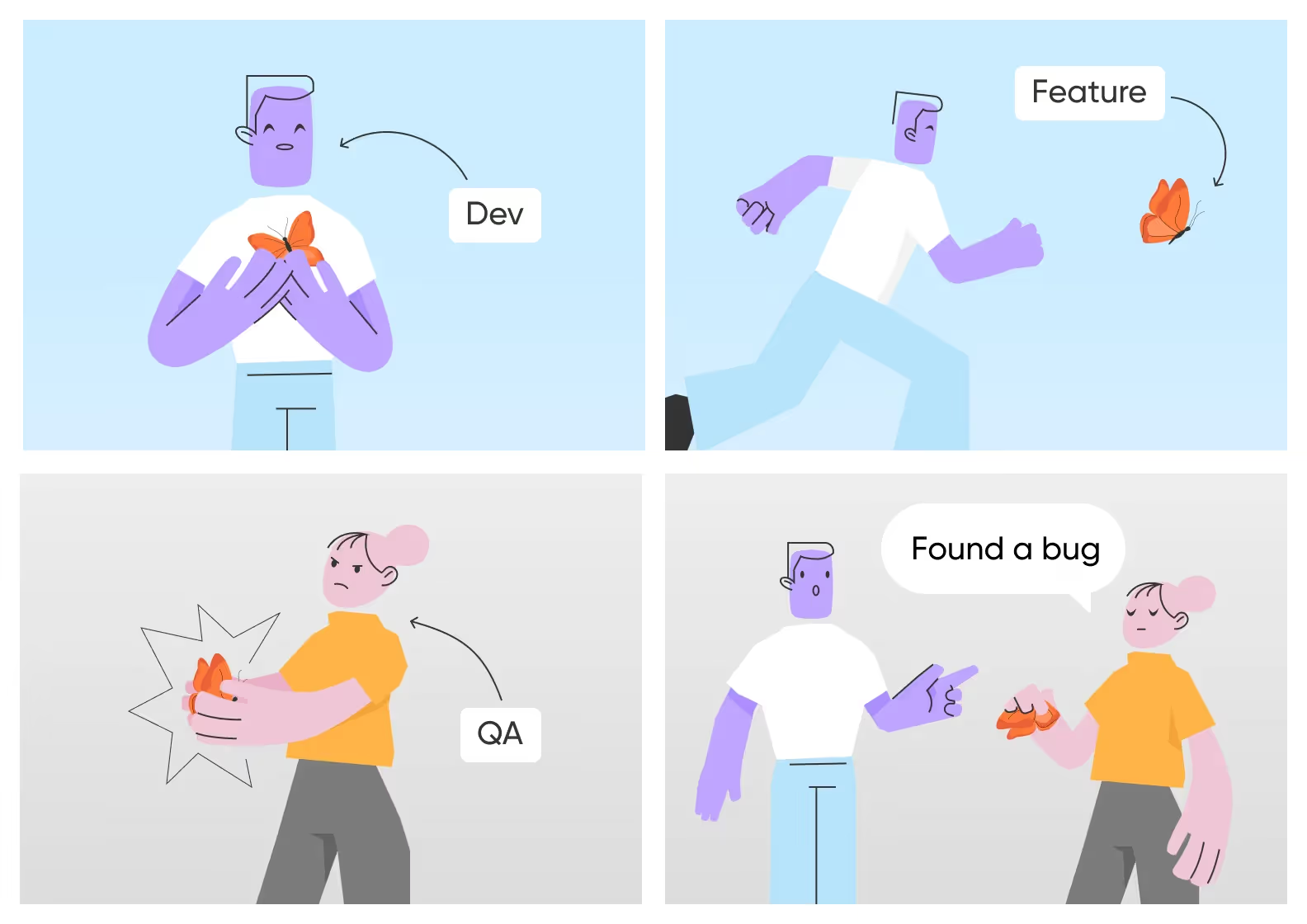
In this article, we’ll touch on 9 software development methodologies that may be suitable for your project. There are two ways to go through it: you can either read about each approach, or you can pick the one that interests you from the comparison table. On the right, you’ll find the table of contents — click on any section and jump straight to it.
To make it easier for you to navigate through the article and find the right approach for you, we have compiled an overview table comparing the top 9 software development methodologies on various criteria:
And now, let’s discuss these software development approaches in more detail.
The Waterfall method is a linear approach to software development. It is characterized by a well-defined, disciplined software management process where each phase of the project must be completed before the next one begins. The model typically consists of the following development stages: requirements, analysis, design, implementation, testing, deployment, and maintenance.
Waterfall is particularly suitable for well-defined software development projects where the requirements are stable and unlikely to change significantly during development. It offers a clear project scope and a structured approach, making it easier to manage and plan for resource allocation.
Here’s a diagram of how the Waterfall software development methodology works:
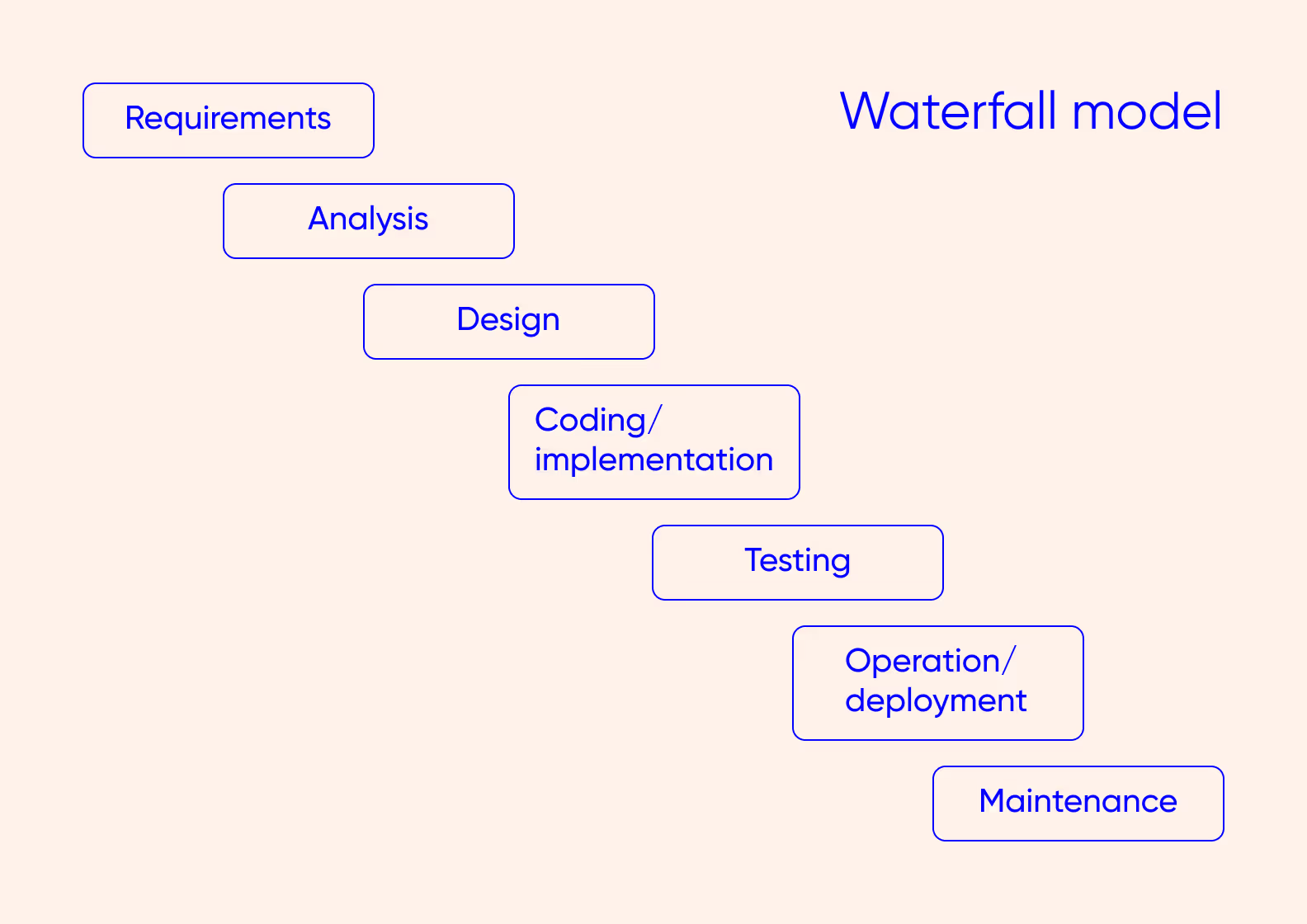
✅ The Waterfall development method is best suited for projects with a clear end goal and well-defined requirements that are unlikely to change over time. It works well in environments where the technology, tools, and processes are well-established and not subject to frequent changes. Waterfall can be effective for large-scale projects with extensive planning and documentation needs.
❌ However, Waterfall is not well-suited for projects with changing objectives or timelines. It can be inflexible, with little room for changes once a phase is completed. Projects that involve research, experimentation, or innovation may not fit the Waterfall methodology, as they often require frequent adjustments.

The Agile methodology focuses on flexibility, collaboration, and efficiency to deliver a quality software development project. It is an iterative approach that also prioritizes user feedback and the ability to adapt to changing requirements. The Agile software development cycle can be broken down into the following six steps: concept, inception, iteration, release, maintenance, and retirement.
Agile divides the project into small, manageable iterations or increments, typically lasting 2–4 weeks. This software development approach is widely adopted in the software industry and has also found application in other fields, such as project management, product development, and even non-software-related initiatives. Organizations often tailor the Agile principles to fit their specific needs.
Here’s a scheme of how the Agile methodology works:

✅ Agile software development is suitable for projects that require flexibility and continuous improvement. It is best for projects with changing requirements, where the ability to adapt quickly is essential. It’s also ideal for projects that involve innovation and experimentation. In terms of team size, Agile is effective for small to medium-sized teams that can collaborate closely and make decisions quickly.
❌ However, Agile may not be the best fit for projects with a lack of collaboration and communication. It may not work for large projects that demand a rigid structure and a lot of documentation. This method is also not suitable for projects with insufficient participation of the product owner where it’s impossible to reach them to get feedback, or they simply don’t have time for it.
Scrum is an Agile-based framework. It is designed for teams of ten or fewer members who break their work into goals to be completed within specific time-bound intervals, called ‘sprints.’ Scrum promotes the self-organization of team members in solving complex tasks and constant reflection on their wins and losses for further improvement.
This framework is built to help teams naturally adapt to changing environments and user requirements. At the same time, short release cycles allow them to improve their performance. Scrum provides structure, optimizes development to achieve efficiency, and remains flexible and accommodating of particular needs.
Here’s how the Scrum development methodology works:
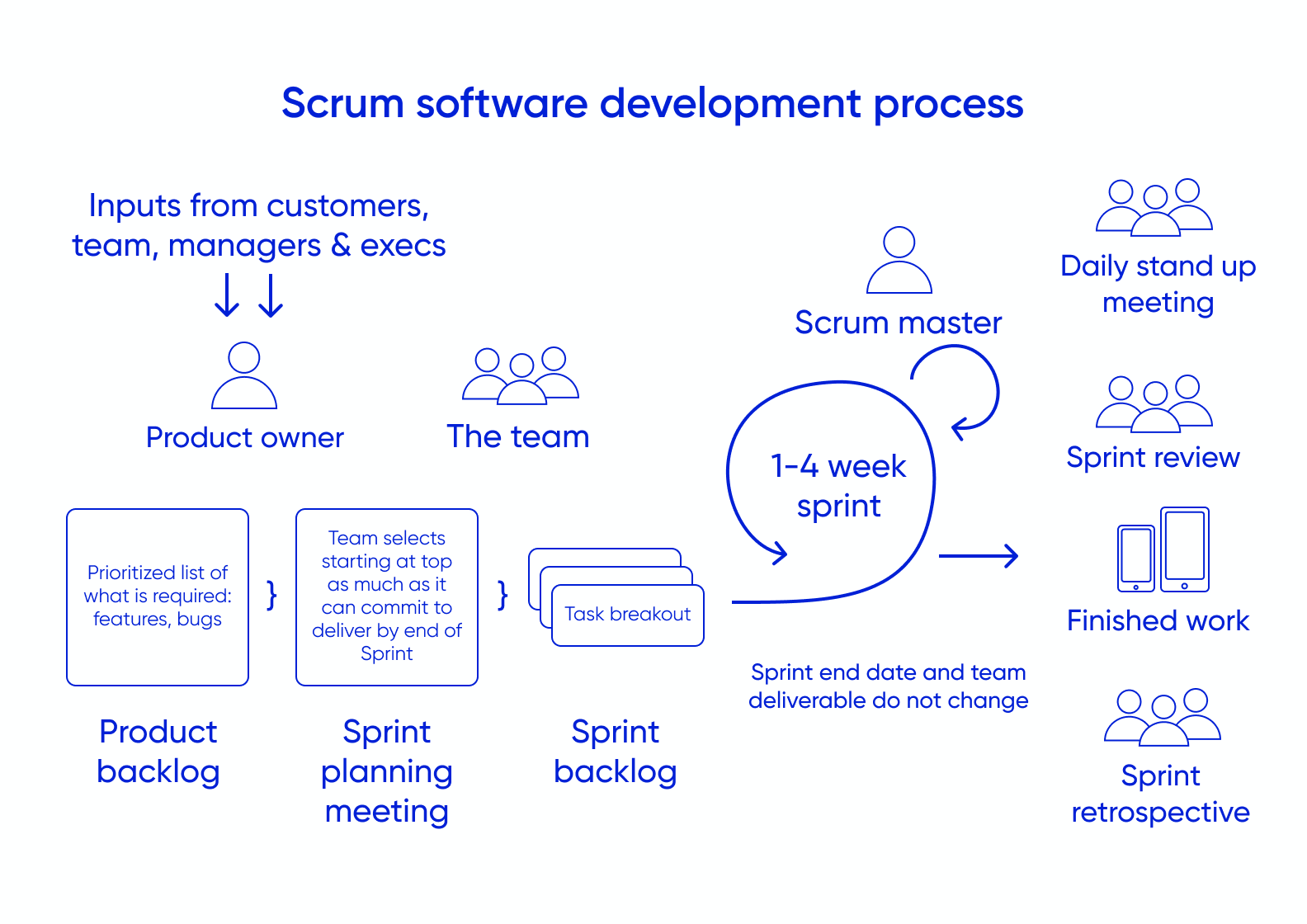
✅ Scrum is suitable for projects that require flexibility and collaboration. It works well when requirements and timelines change or when the market is highly competitive. Endeavors that require active involvement of the product owner, feedback, and rapid response to user needs align well with Scrum’s customer-centric approach. At Purrweb, we use Scrum for our projects.
❌ However, Scrum may not be suitable for projects that require strict regulatory compliance and projects where it is not possible to set even short, one-week sprint goals. It also won’t work out for projects with no product vision, lack of good technical practices, skill shortage, conflicts in the team, and other fundamental issues.
Lean development is another one of the Agile-based software development methodologies. It strives to improve efficiency by eliminating waste. Lean development methodology emphasizes delivering only what is necessary, reducing unnecessary work, and increasing user satisfaction.
By reducing tasks and activities that don’t add real value, the team reaches optimal efficiency. Waste in this case can include unnecessary features, redundant code, inefficient processes, and overproduction of documentation. Work is divided into small, manageable batches that can be completed quickly. This reduces lead times and simplifies custom feedback.
The Lean development methodology looks like this:
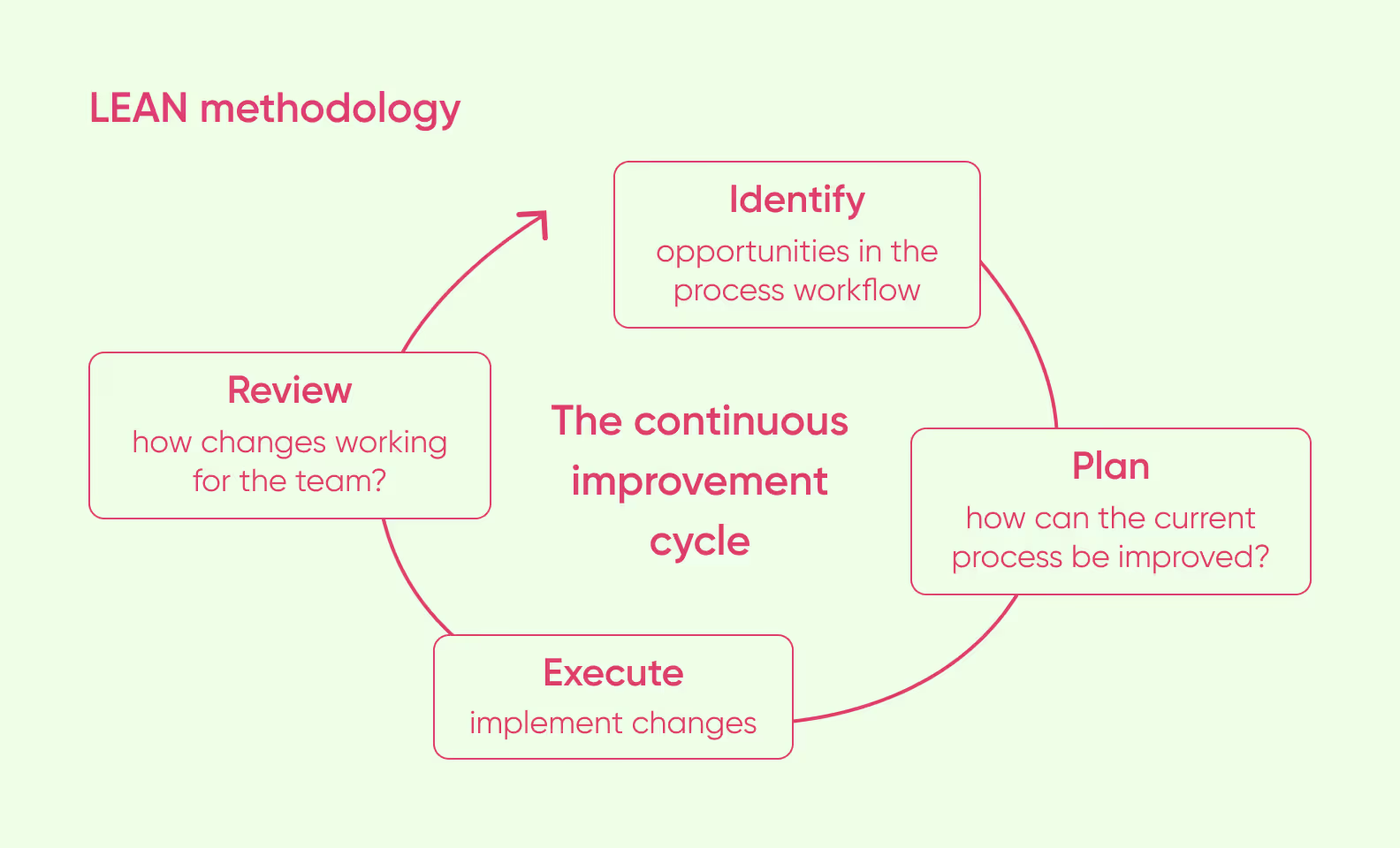
✅ Lean software development methodology is suitable for small and medium-sized projects that require a focus on delivering value to the users and flexibility. It works well for projects that require a high level of collaboration, continuous improvement, optimization of the development process, and a focus on efficiency and waste reduction.
❌ However, Lean development may not be suitable for highly regulated industries or large projects with stringent requirements that require extensive documentation. This app development method may also be a poor choice for projects that require a more structured management approach or a focus on long-term planning and strategy.
The Prototype model is an iterative approach used in software development. The Prototype software development methodology refers to creating a working model or prototype of the software before developing the final product. This model is useful for testing and validating the business ideas.
Prototyping allows the product owner to see and interact with the user interface and software functions. The early visualization helps clarify ideas that may otherwise remain abstract. Although prototyping initially adds an additional step to a project, it can speed up development in the long run. With clear requirements and design, the development team works more efficiently.
Workflow with a Prototype method is as follows:
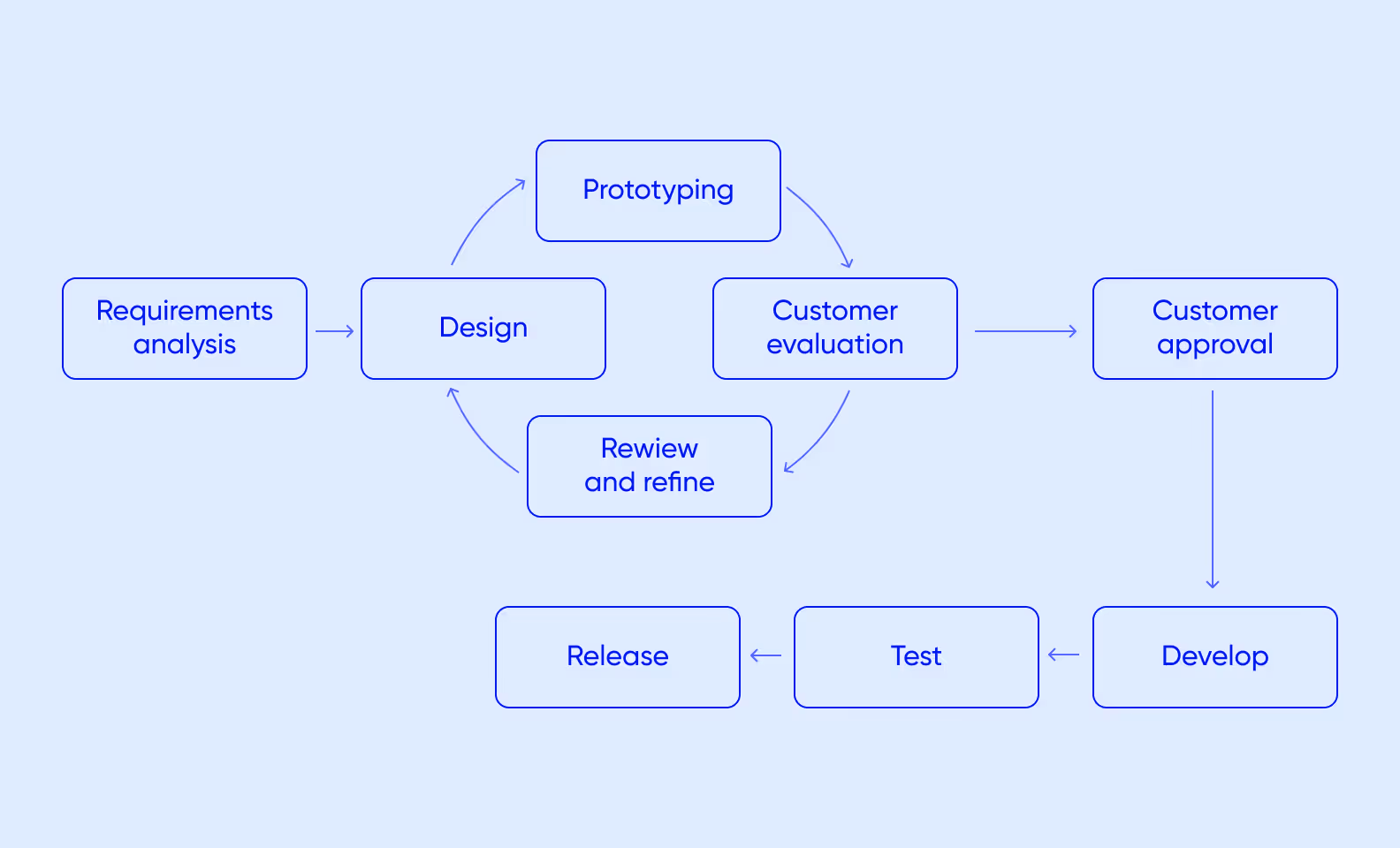
✅ The Prototype app development methodology is suitable for projects with many unknowns, where the development team needs to work on the prototype version of the final product. It is ideal when detailed documentation is not needed, and the focus is on user feedback and validation.
❌ However, the Prototype model may not be suitable for projects with fixed deadlines and a compliance focus. This approach may also be redundant for apps with very well-defined and simple requirements.
Extreme programming (XP) is an Agile-based software development model that emphasizes teamwork, communication, and rapid feedback. XP is considered the most radical form of Agile software development, differing markedly from other approaches.
XP is customer-driven, encouraging software development companies to be creative in meeting user needs. This methodology emphasizes testing and code quality, resulting in fewer bugs and higher software quality.
Here’s the XP development methodology workflow:
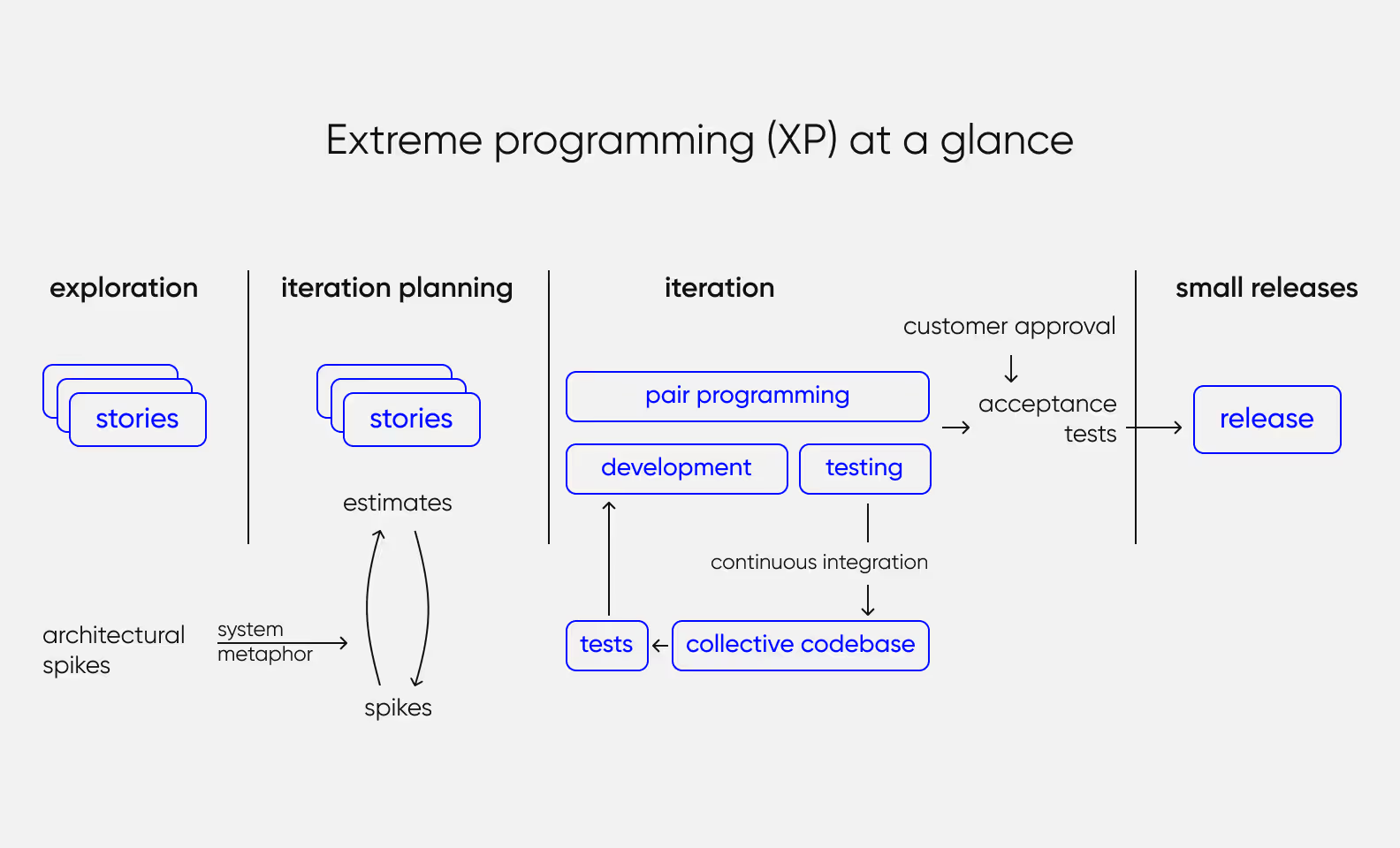
✅ XP is suitable for small and medium-sized projects that require a focus on the needs of end users and rapid feedback, as well as a high level of collaboration and communication among team members. It is best suited for projects oriented towards creating high quality software products. The XP software development methodology may be a good choice for those who want to reduce administrative overhead.
❌ However, XP may not be the best fit for projects in highly regulated industries or those with rigid, non-negotiable requirements. It may not be suitable for projects with fixed timelines that require a lot of documentation and planning. Teams accustomed to traditional software development methodologies may resist the changes associated with XP, such as pair programming and frequent interaction with the product owner.
Rapid application development is an iterative software development methodology that prioritizes speedy development and frequent prototyping. It is used to quickly produce functional software apps. RAD is a progressive development model that focuses on user feedback and collaboration to speed up project delivery and avoid expensive changes.
RAD uses rapid development tools and frameworks, often relying on visual development environments to accelerate the creation of software. Under this methodology, regular user testing and collaboration together ensure that software meets user expectations.
Here’s a flowchart that shows how rapid application development happens:

✅ RAD is useful for developing small to medium-sized projects within tight deadlines. It is well-suited for projects that require rapid prototyping and proof of concept to test ideas quickly. RAD works well for projects with unclear requirements that require user feedback and adaptation.
❌ However, RAD may not be suitable for projects with limited resources or when team members participate in other projects. Very large projects may struggle to handle rapid iterations and may require more structured management approaches. Projects in highly regulated industries with stringent compliance requirements may also find it difficult to adopt RAD.
The dynamic systems development methodology (DSDM) is mainly based on the concept of rapid application development. In many ways, it is similar to SCRUM and XP.
What sets this software development methodology apart is its strong focus on project governance and risk management. DSDM establishes the project’s cost, quality, and time as unchangeable fixed milestones.
All the project requirements are prioritized through the MoSCoW system. If the project isn’t meeting the schedule or budget, the changes are discussed with the stakeholders, and then the lowest priority requirements are dropped.
Here are the visualized project phrases of the dynamic systems model:

✅ DSDM is best suited for medium and large projects with tight deadlines, a need for strong governance, and potentially changing requirements. This software development methodology is effective only for companies where the client actively participates in the development and implementation process.
❌ However, the dynamic systems model is not suitable for projects where all requirements are already known, and the outcome is clear. In this case, DSDM may be unnecessarily complex. Also, if the client is not ready to be actively involved in the project, DSDM may not be the best choice.
Feature driven development is an Agile software development methodology that focuses on delivering small features or function blocks. FDD is iterative and incremental, with the goal of delivering tangible results frequently and efficiently.
There are five major FDD activities: developing the overall model, generating a feature list, planning by feature, designing by feature, and building by feature. FDD encourages status reporting at all levels to help track progress and results. It is typically used in large-scale development projects.
Here’s a scheme of how FDD works:
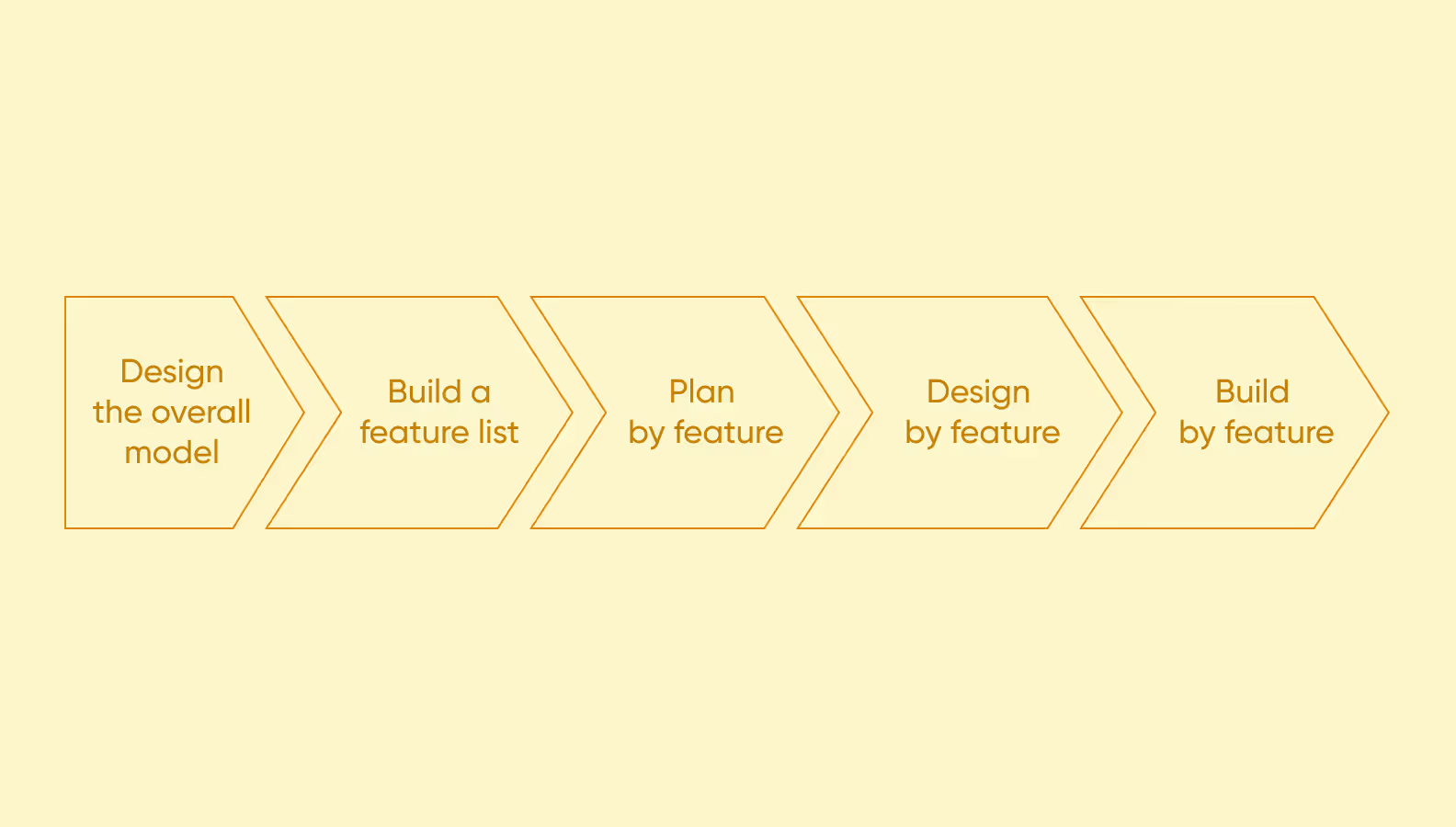
✅ FDD is suitable for development teams looking for a simple but structured Agile method that is scalable and produces predictable results. FDD is user-friendly and encourages the use of documentation. It is best suited for large projects that still require flexibility.
❌ However, this method may not be suitable for projects that require a more structured linear approach. FDD may introduce unnecessary complexity for small-scale projects with straightforward requirements. Projects focused on research and exploration of new technologies may not benefit from the feature-driven approach.
Our team knows how important it is to choose the right software development methodology for startups. At Purrweb, we use Scrum for management and Kanban for task visualization, time limitation, and continuous work process. We have chosen an approach that helps managers maintain control over the development process at all stages of product creation.
For us, the optimal duration of a sprint in the development process is two weeks. One week may not be enough to develop complex functions, and the team will not be able to provide the product owner with the final result.
In addition, we adhere to the full development cycle and use cross-platform application development, which are characteristic features of the Agile methodology.
We developed a mobile app called Petbuddy for a veterinarian who owns a small clinic in Germany. The app is designed to help pet owners take good care of their pets by tracking their health indicators. Purrweb’s team used the Scrum management methodology to develop this app, as we worked closely with the product owner to ensure the development was kept under control.
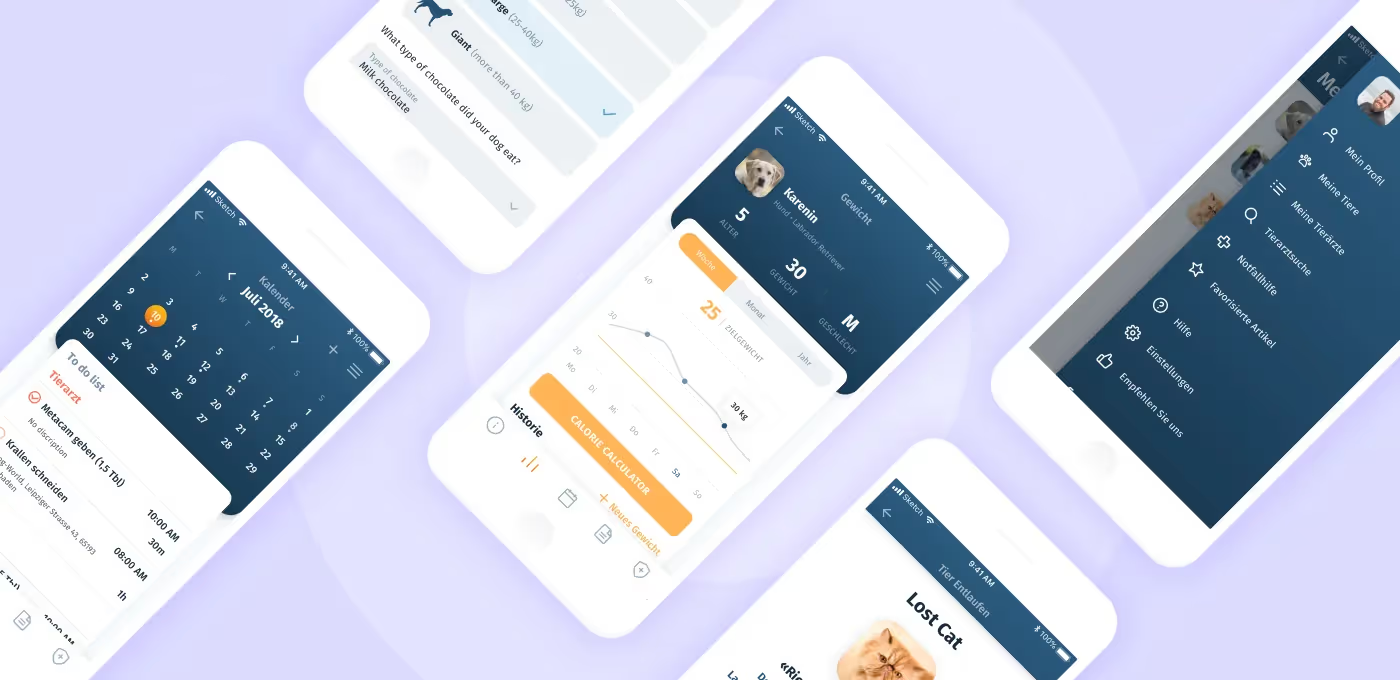
When developing EnerGO, an app for power bank rent, we were to make it compatible with the Chinese charging stations. It was our first IoT project that we managed to complete successfully. Even though there were some challenges, close communication between the product owner, our designers, developers, and the PM has helped us significantly. Despite the effect of the pandemic and a lockdown in China that caused delays, the client was satisfied with the end result.
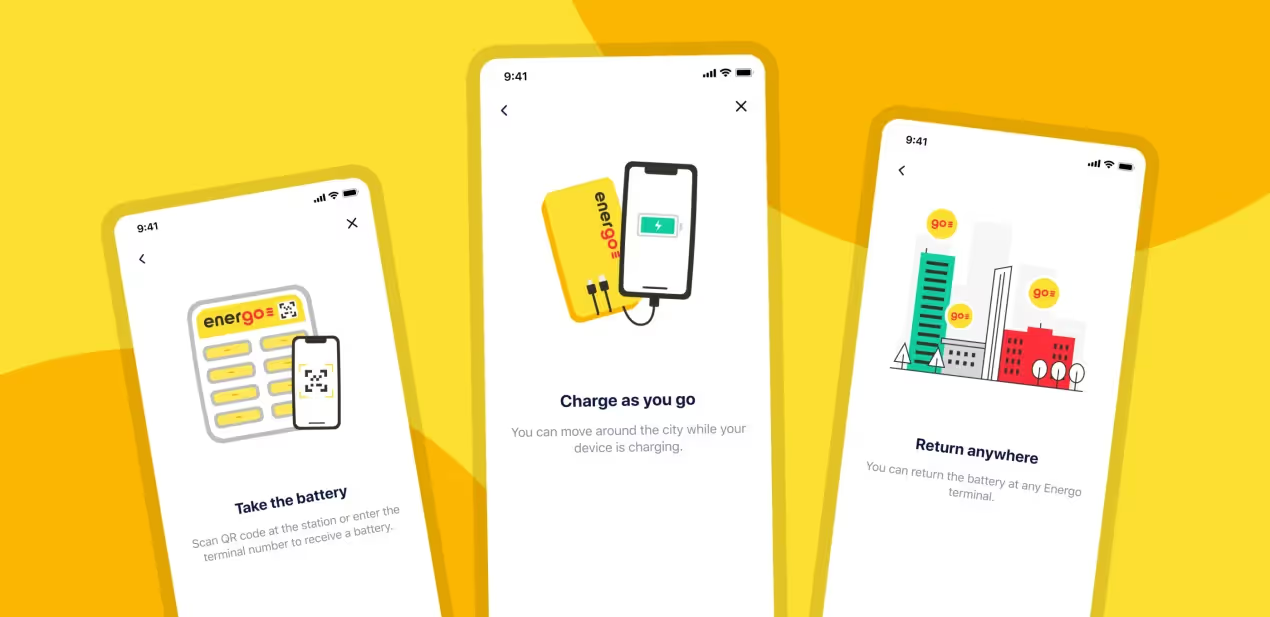
In this article, we discussed eight different software development methodologies, each with its own unique approach to guiding the software development processes. Each methodology is project-specific and has its own set of pros and cons. The choice of methodology depends on the project’s requirements and constraints.
No matter which methodology your team chooses, the software development life cycle will remain approximately the same and will look like this:
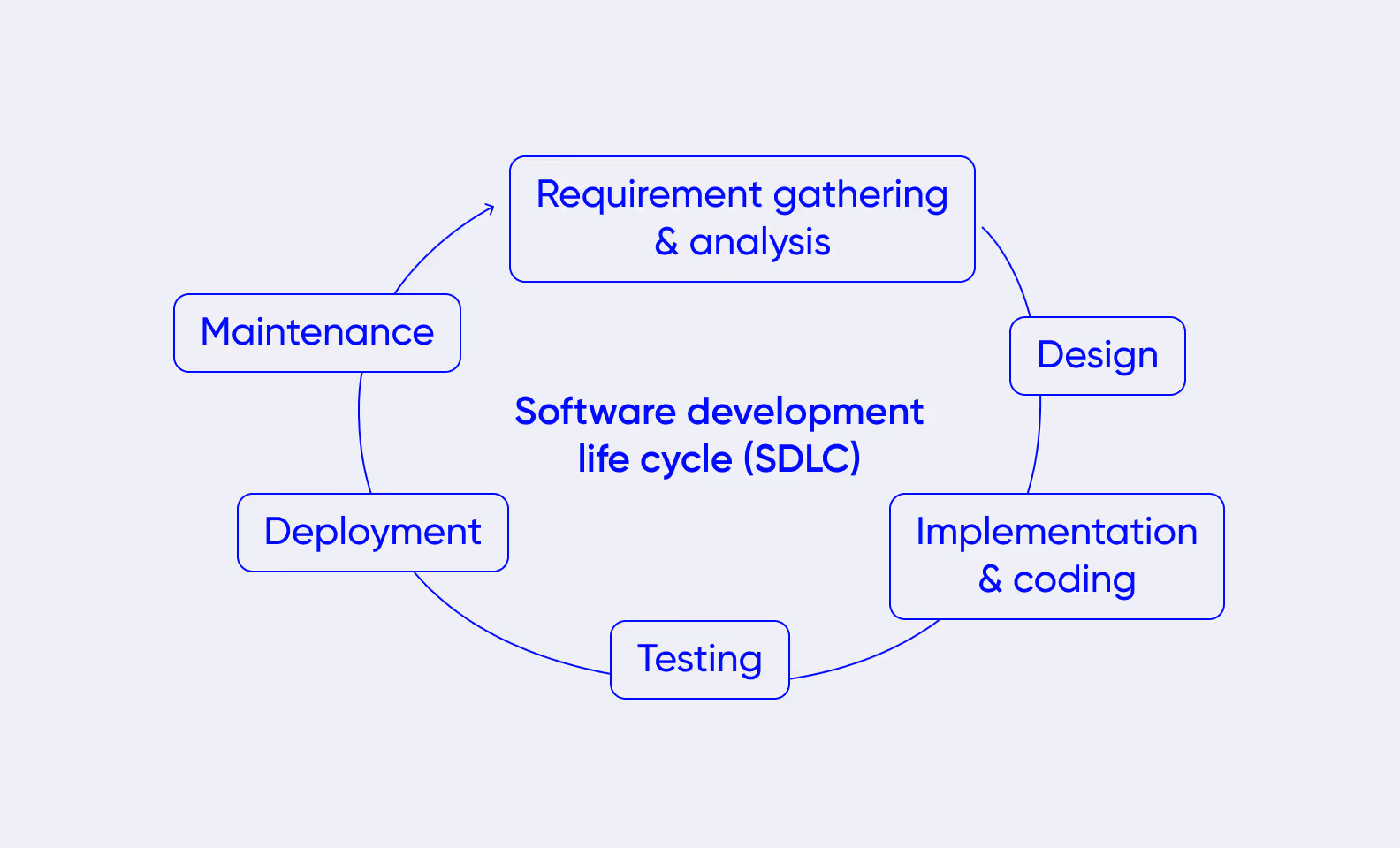
Our managers know how to develop a successful project, so if you need a team of specialists, contact us. At Purrweb, we will take care of planning, design, development, and post-release maintenance.
<a class="blog-modal_opener">Fill out the form</a> to receive an individual quote.